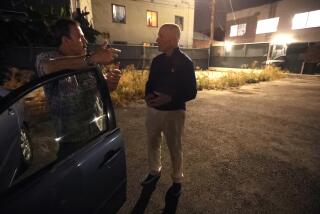Giving the homeless a digital voice
Mark Horvath, a documenter of homelessness who was once homeless himself, was touring a tent city in Sacramento when he raised his cellphone to take a photo of one man’s ingenious shopping-cart storage system.
Suddenly, another man rushed at him, screaming, with a knife.
Horvath was terrified, he said, but not so scared that he stopped sending photos and text messages about what was happening.
“I am a little scared because people will protect their home and everyone is angry,” read one, followed soon after by another: “One man . . . starts screaming at me. I walk away. Two guys follow me to my car. I’m scared.”
Five hundred miles away in Los Angeles, Heather Meeker sat on the edge of her chair staring at her computer screen, anxious for Horvath’s next update.
Meeker is director of marketing and communications for the social media storytelling website Whrrl, which lets users create online storybooks using their own photos and captions.
She was afraid, she said, that Horvath was going to be attacked mid-message.
As it turned out, the encounter ended peacefully. It also led to a relationship between Horvath and Whrrl that has helped turn Horvath into one of the Internet’s most outspoken homeless advocates.
In recent months, he’s become a darling of the social media industry, followed on Twitter and sought after as a speaker at conferences.
Last week, with corporate sponsorship, he set off on a two-month nationwide tour of homeless encampments -- a grander version of what he has been doing over the past year.
In stories on Whrrl and videos he posts on his blog and on Twitter, Horvath lets homeless people talk -- raw and unscripted -- about their panhandling, lost children, drug addictions, sorrows and hopes. He punctuates their words with plenty of his own.
“I’ve often heard people who were never homeless themselves talk about what a lucrative job [panhandling] must be,” he wrote this spring. “Please note: panhandling is not a good career move. Besides the humiliation, it’s very dangerous and . . . the perks are not all that great . . . people spit on you.”
Such frankness is unusual in a world in which many advocates are hypercareful about avoiding negative stereotypes.
The National Alliance to End Homelessness estimates that 2.5 million to 3.5 million people experience homelessness each year in the United States, including 600,000 families and 1.35 million children. Many live in motel rooms, cars or shelters, but tent cities have sprung up in growing numbers across the country.
Telling the stories of the homeless is personal for Horvath, who worked in television before hitting bottom as an alcoholic. He was homeless himself for several months in 1995. With his 6-foot-long pet iguana, he made money posing for tourists’ pictures on Hollywood Boulevard.
He got clean with the help of a church, the Dream Center, and spent more than a decade working for various churches around the country helping them boost their media presence.
But last year, after he lost a job and then his home to foreclosure, he began to fear that once again he could wind up on the street. The prospect, he said, filled him with terror and hopelessness.
To keep the fear at bay, and because he is so full of energy that spending time with him can be both invigorating and exhausting, he threw himself into documenting homeless life and culture.
He now does so on a variety of platforms -- his blog, Twitter, Facebook.
On Wednesday, he set out in a Ford Flex on loan to him by the car company’s head of digital media, full of socks to hand out along the way.
The first day was a typical frenzy of activity. He drove to Las Vegas and, despite the 116-degree heat, immediately sought out a homeless encampment.
Within hours, he had posted photos of a wasted-looking, shirtless man, whose vacant eyes and faraway expression echo the Depression-era photographs of Dorothea Lange.
Those who follow Horvath -- about 2,900 of them on Twitter alone -- talk about the immediacy of his work, his way of forcing viewers to connect with the people he films.
Take an interview he did in May with a couple and their 15-month-old daughter:
With no introduction, Horvath asks: “Natasha, David and Tish, tell me, what’s it like being a homeless family?”
On the video, David winces, as his wife looks at their daughter, smiling, squirming and playing with a plastic cup.
“It’s rough,” he says. “Every day is a struggle. . . . We do the best we can to stay upbeat.”
A minute later his wife, whose face alternates between hope and defiance, interjects. “I get tired of, ‘You people this,’ ” she says. “We’re homeless. We’re not less human.”
Natalie Komuro, executive director of PATH Achieve, Glendale’s largest homeless provider, said she has been struck by Horvath’s ability to engage people “who have no contact with homeless people to actually see their story.”
At the same time, she said, when she gave him a temporary job working with the homeless in winter shelters, she was somewhat alarmed to discover the number of updates he was posting on Twitter and told him he needed to do them on his own time -- without mentioning her agency or its clients.
“What Mark is proposing is a very different kind of model that forces agencies to relinquish some control,” she said.
Horvath responds unapologetically: “What are you going to do when they [the homeless] are all on Twitter?”
What makes homeless activists nervous thrills social media types.
“He is using social media to try to make real change,” said Meeker, of Whrrl. “In the tech community in New York, Los Angeles, San Francisco, there are some key players who understand what Mark is doing, and they are very interested.”
After following Horvath’s tent-city encounter with the angry man, which he chronicled on Whrrl, Meeker flew him to Seattle to talk to the company’s employees.
Soon he was receiving other invitations -- including one to the Idea Camp, a conference in Washington, D.C., this summer. It was that invitation that gave him the idea for his road trip.
With the relentless enthusiasm his network has come to know well, he sought sponsors -- and while some said no, many said yes. Individuals who read his blog gave him money. So did the Union Rescue Mission.
The day before he set out, Horvath hit Hollywood Boulevard.
With his black backpack stuffed with socks and a fuzzy microphone tucked under his arm, he swept past tourists and the crowd at Michael Jackson’s star.
He was headed for a woman in a wheelchair, with spaces where her front teeth should be and a catheter snaking out from a hole in her blue sweat pants.
He addressed her by name, Viper, and asked: “Where did you sleep last night?”
“Down on Highland,” she answered, adding that her seizures were troubling her and that it was hard to stay cool, especially with new medications making her sick.
Then Horvath posed one of his trademark questions.
“If you had three wishes,” he asked, “what would they be?”
At first, she answered promptly: “Housing.”
Then what had been a steady smile crumpled and tears began to fall.
“Seeing my daughter,” she added. “Being around family.”
That night, Horvath posted Viper’s interview on his website, with this note: “Six months ago, I cautioned that her story is tough to watch. Today, I must again. . . .”
--
More to Read
Sign up for Essential California
The most important California stories and recommendations in your inbox every morning.
You may occasionally receive promotional content from the Los Angeles Times.






